Growing a bird of paradise plant indoors can make any space feel like a tropical oasis. I’ve learned how these plants add vibrant energy to homes. Their orange and blue flowers look like tropical birds in flight, making them a standout.
This guide shares my best methods for growing strelitzia indoors. Whether you’re new to plants or have experience, I’ll cover lighting, watering, and troubleshooting tips. Let’s make your home a piece of paradise together.
Introduction to the Stunning Bird of Paradise
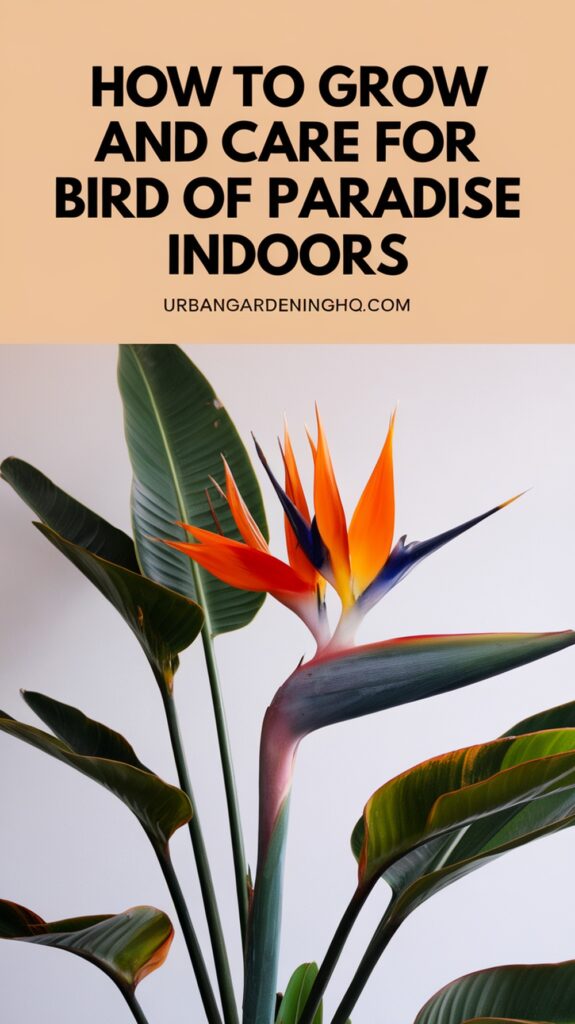
The Bird of Paradise is a standout with its bold leaves and exotic flowers. It’s perfect for adding a touch of the tropics to your home.
Origin and Natural Habitat
The Bird of Paradise comes from South Africa. It loves the warm, humid coastal areas and forest edges. Knowing where it comes from helps us care for it better indoors.
Why Bird of Paradise Makes an Excellent Houseplant
These plants are surprisingly good indoors. Here’s why:
- Architectural beauty: Their big, banana-like leaves bring a tropical vibe.
- Low-maintenance routine: They can handle neglect well once they’re settled.
- Indoor bird of paradise benefits: They clean the air and keep their leaves for a long time.
What to Expect When Growing Indoors
Growing indoors requires patience. Here’s what I’ve learned:
| Aspect | Indoor Growth | Outdoor Growth |
|---|---|---|
| Plant Size | 6-8ft tall | Up to 20ft |
| Flowering | Rare but possible with light control | Regular blooms |
| Maintenance | Requires consistent humidity | Naturally suited |
Don’t believe the myth about needing constant wet soil. Too much water can cause root rot. With the right care, these plants can live for many years.
Different Bird of Paradise Varieties for Indoor Growing
Choosing the right Bird of Paradise involves knowing its types. Strelitzia reginae and Strelitzia nicolai are top picks for indoor gardening. Each variety has its own charm, fitting different home styles.
Strelitzia reginae (Orange Bird of Paradise)
The orange bird of paradise, Strelitzia reginae, dazzles with its vibrant orange and blue flowers. It grows 4–5 feet tall, perfect for most rooms. Its compact size is ideal for apartments or smaller homes.
- Flower color: Orange and blue
- Max indoor height: 4–5 feet
- Light needs: Bright indirect light
Strelitzia nicolai (White Bird of Paradise)
The white bird of paradise, Strelitzia nicolai, boasts white and blue blooms. Indoors, it can reach up to 20 feet tall. It needs more space and light than the orange variety. It’s best for sunrooms or rooms with high ceilings.
- Flower color: White and blue
- Space needs: Large rooms or open areas
- Light preference: Full sun to partial shade
Choosing the Right Variety for Your Space
First, think about your room’s size and light. For smaller spaces, Strelitzia reginae is a great choice. The white bird of paradise is better for larger areas. There are also rarer types like Strelitzia juncea, but they require careful care. Learn about different bird of paradise to find the perfect one for your home.
Light Requirements for a Thriving Bird of Paradise
Bird of paradise plants need bright, indirect light to grow well. They do best near a south-facing window. I’ve found that 6 hours of light a day keeps them looking great and encourages flowers.
It’s important to avoid direct sun, as it can burn the leaves. Low light, on the other hand, slows them down. A south-facing window is perfect, but an east-facing spot works too. Make sure to rotate your plant every month for even light.
- Signs of too little light: leggy stems, delayed blooming
- Signs of too much light: crispy edges on leaves
In darker rooms, LED grow lights can help. Use them for 12-14 hours a day. Move plants to brighter spots slowly to avoid shock. If leaves turn yellow or droop, it’s time to change their spot.
My experience shows that the right mix of light quality and duration is key. Keeping light consistent is essential for healthy, lush foliage.
Selecting the Perfect Pot and Soil Mix
Choosing the right pot and soil is key for your Bird of Paradise to thrive. It needs the right setup from the roots up to bloom brightly.
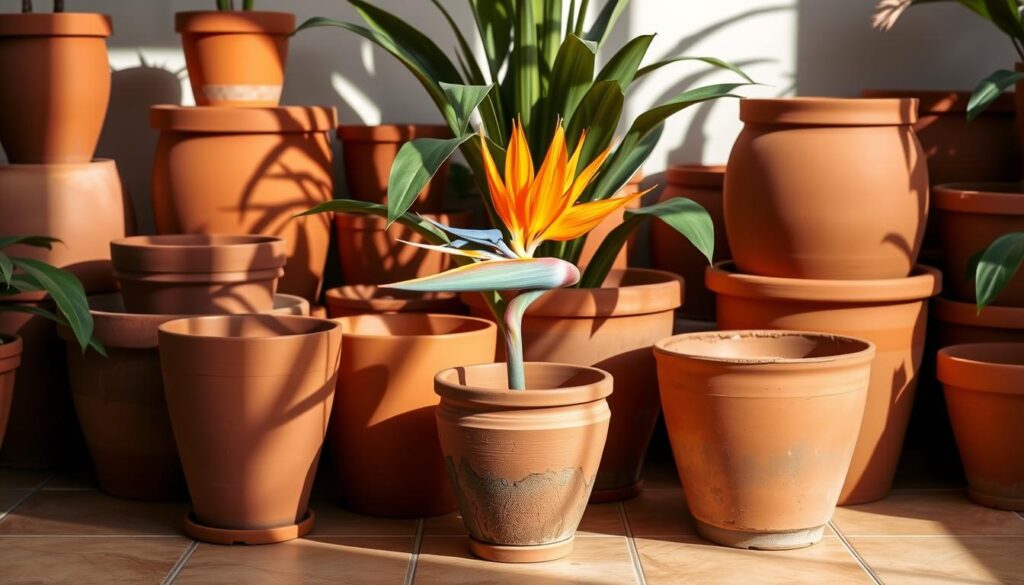
Best Container Types and Sizes
Start with a bird of paradise pot size 2-4 inches wider than the nursery pot. Terracotta pots are great because they’re heavy and let soil breathe. Don’t pick small pots; they can harm your plant’s growth.
Look for these features:
- Material: Terracotta or ceramic for stability and drainage
- Drainage holes: Always check for 3-4 holes to prevent waterlogging
- Size: Match the pot to your plant’s current size, not its future size
Ideal Soil Composition
A well-draining soil mix is essential to avoid root rot. Mix together:
- 2 parts premium potting soil
- 1 part perlite for airflow
- 1 part orchid bark to retain moisture without sogginess
Stay away from heavy soils or garden dirt that holds too much water.
When to Repot Your Plant
| Sign | Action |
|---|---|
| Roots visible through drainage holes | Repot immediately |
| Circular roots at soil surface | Repot during spring |
| No new growth for 6+ months | Check roots before repotting |
Repotting strelitzia is needed every 2-3 years or when roots outgrow the pot. Never force a plant into a too-large pot—it stresses the roots. For established plants, a bit of root confinement can encourage flowering.
Pro tip: Use pot feet under containers to elevate plants and improve airflow. This simple step prevents water pooling and keeps soil aerated.
Watering Your Bird of Paradise Correctly
Watering your Bird of Paradise right is key to its health. This guide will help you avoid common mistakes and keep your plant happy indoors.
Establishing a Watering Schedule
Watering your Bird of Paradise needs a balance. Wait until the top 2–3 inches of soil are dry before watering again. Use the finger test or a moisture meter to check.
Adjust how often you water based on the season. Water less in winter and more in summer. Clay pots dry faster than plastic, so adjust your watering schedule.
Always empty the saucer after watering to prevent root rot.
Signs of Overwatering and Underwatering
- Overwatering causes yellow leaves, soft stems, and root rot. Fungus gnats near the soil signal too much moisture.
- Underwatering leads to leaf curling and crispy brown leaf edges. Wilting leaves that feel papery to the touch mean it’s time to water.
Humidity Requirements and Management
Bird of Paradise plants love humidity between 40–60%. To increase moisture without overwatering, try:
- Grouping plants to create a humid microclimate.
- Using pebble trays filled with water.
- Misting leaves gently in dry climates.
- Placing the plant in a bathroom or kitchen with natural humidity.
- Using a humidifier in arid regions.
Avoid stagnant air by ensuring good airflow to prevent fungal issues.
Temperature and Climate Considerations
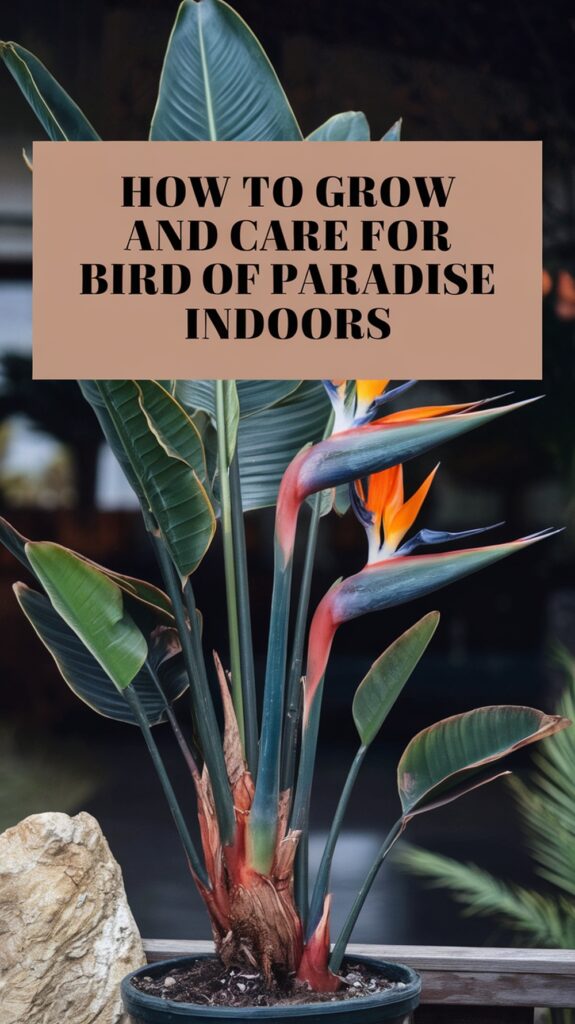
Knowing the bird of paradise temperature range is essential for its health. It prefers daytime temperatures between 65-85°F (18-29°C). Nights should not drop below 55°F (13°C). Avoid placing it near drafts or heating vents to prevent stress.
In winter, tropical plant winter care becomes more critical. Moving the plant 2-3 feet from cold windows helps prevent cold damage. Here’s how to protect your plant:
- Wrap pots in insulating fabric if near entryways
- Use humidifiers to counteract dry indoor heat
- Check leaves weekly for dark spots or brittle edges – signs of draft protection failure
If it gets colder than 50°F (10°C, move it to warmer spots. Symptoms of cold damage, like blackened leaf tips, need quick action. Trim damaged parts and adjust its position. For summer, slowly introduce it to outdoor shade over 1-2 weeks. Never expose it to direct sunlight or freezing drafts.
Keep a thermometer near the plant to track temperature changes. Proper climate control leads to healthy foliage and stunning blooms. A stable environment means less recovery time and more joy from this tropical beauty indoors.
Fertilizing for Optimal Growth and Blooming
Proper nutrition is key for the Bird of Paradise’s growth. I’ve tested bird of paradise fertilizer types for indoor plants. Let’s explore what works best.
Best Fertilizers for Indoor Bird of Paradise
Here are some options based on your plant’s needs:
- Liquid indoor plant food: Use diluted solutions every 4-6 weeks when plants are growing. I like 10-10-10 formulas like Jobe’s or Miracle-Gro for balanced nitrogen phosphorus potassium ratios.
- Slow-release pellets: Osmocote pellets release nutrients slowly. They’re great for busy people but avoid overusing to prevent salt buildup.
- Organic blends: Fish emulsion or compost tea provide gentle nutrition. They’re safer but need more frequent use.
Seasonal Feeding Schedule
Follow this schedule to match your plant’s natural cycles:
- Spring-Summer: Feed every 2-3 weeks with a balanced bird of paradise fertilizer. Use a bloom booster (like 10-20-10) in early spring to boost blooms.
- Fall-Winter: Feed monthly or skip it. Plants need less during this time, so too much can harm roots.
Too much fertilizer can burn leaves and rot roots. Always water well before feeding to dilute salts. Also, flush soil monthly with clear water to avoid mineral buildup. Tap water can block nutrient uptake—use reverse osmosis water if your tap water is too chlorinated.
Pruning and Maintenance Tips
Keeping your Bird of Paradise healthy and beautiful is key. Here are some easy steps to help. Start by pruning bird of paradise by cutting off damaged or yellow leaves. Use clean shears to prevent spreading diseases.
Natural leaf splitting happens as leaves grow, but sudden splits mean too much water or pests. Only trim what’s necessary to promote new growth.
When and How to Trim Leaves
Check leaves every week. Cut off damaged ones at the base, cleaning your tools each time. It’s normal for mature leaves to split, but young ones splitting might mean too much water.
Never try to fix split leaves. Let the plant heal on its own.
Cleaning and Dusting Techniques
- Wipe large leaves with a damp microfiber cloth and mild soapy water.
- Occasionally shower the plant in lukewarm water to dislodge dust.
- Avoid leaf shine products—they block pores. Stick to plain water for cleaning plant leaves.
Supporting Tall Plants
As plants grow, plant support stakes are a must. For Strelitzia nicolai, use bamboo stakes or decorative trellises. Secure stems loosely with stretchy plant ties.
Rotate your plant weekly to prevent it from leaning towards the light. This helps it grow straight and reduces the need for too much staking.
Common Pests and Diseases of Bird of Paradise
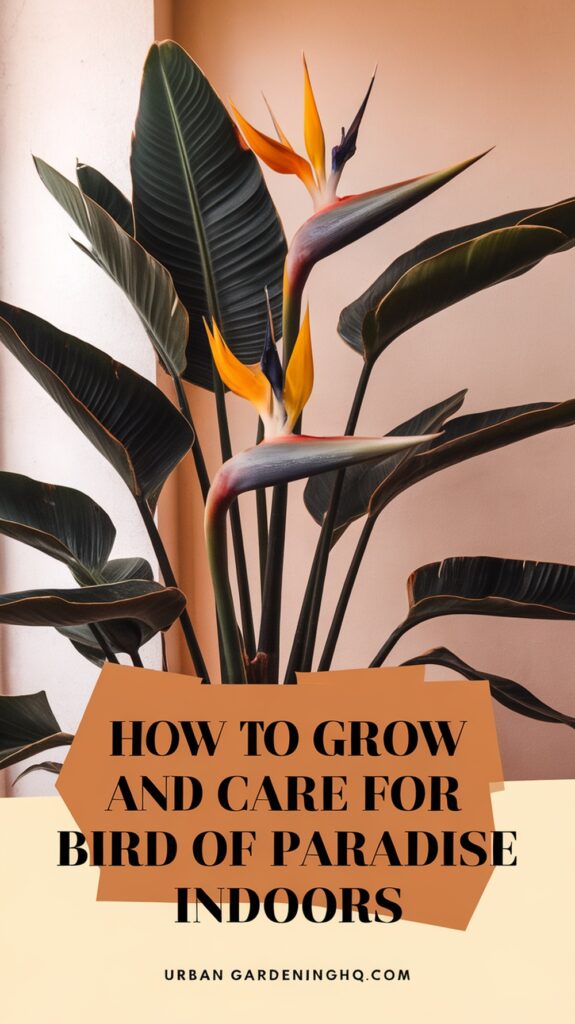
Bird of Paradise plants are tough, but they face challenges. Spider mites are tiny pests that thrive in dry conditions. Look for fine webbing and speckled leaves. Treat them with neem oil or insecticidal soap sprays every 7 days until they’re gone.
Scale insects are another threat. These brown, shell-like bugs cluster on stems and leaves. Wipe them off manually and follow with alcohol swabs. For severe cases, systemic insecticides work best. Mealybugs and aphids also appear occasionally—they’re softer-bodied and respond well to the same treatments.
Root rot strikes when soil stays soggy. Yellow leaves and mushy stems signal this fungal issue. Let soil dry fully between waterings and repot in fresh, well-draining mix. Leaf spot disease shows up as brown or yellow spots. These fungal or bacterial spots need airflow—trim damaged leaves and avoid wetting foliage when watering.
- Prevent issues by inspecting new plants before adding to your collection.
- Keep plants spaced to improve air circulation.
- Quarantine new plants for 2 weeks to stop spread.
Yellowing leaves? It might not be pests. Overwatering or low light often cause browning edges. Adjust care routines first before assuming pests or disease. Regular checks keep your Bird of Paradise healthy and blooming vibrantly.
Propagation Methods for Bird of Paradise Plants
Starting a new Bird of Paradise collection can be done in two ways: dividing plants or growing from seeds. Both methods require patience. Spring is the best time to start, helping new plants recover well.
Division Technique
Root division is best for older plants with too many roots. Here’s how to do it:
- Take the plant out of its pot and loosen the soil to see the roots.
- Use a sharp knife to cut through the roots, making sections with stems and roots.
- Put the divisions in new soil and water them lightly until they start growing.
Be careful not to overwater to avoid root rot. I’ve found that shaded light helps divisions recover well.
Growing from Seeds
Seeds need a scratch on their coat before planting. Soak them in warm water for 24 hours before planting. Keep the soil moist and warm (70–75°F). It can take 1–3 months for seeds to germinate, and plants may bloom in 3–5 years. Growing bird of paradise seeds is slow, like growing basil from seed, needing consistent care.
Best Time for Propagation
Spring is the best time for both methods. Look for new leaves before dividing or sowing seeds. If a plant has too many roots, it’s ready for division. Seeds can be started anytime, but spring warmth helps them grow better.
Conclusion: Enjoying Your Tropical Paradise Indoors
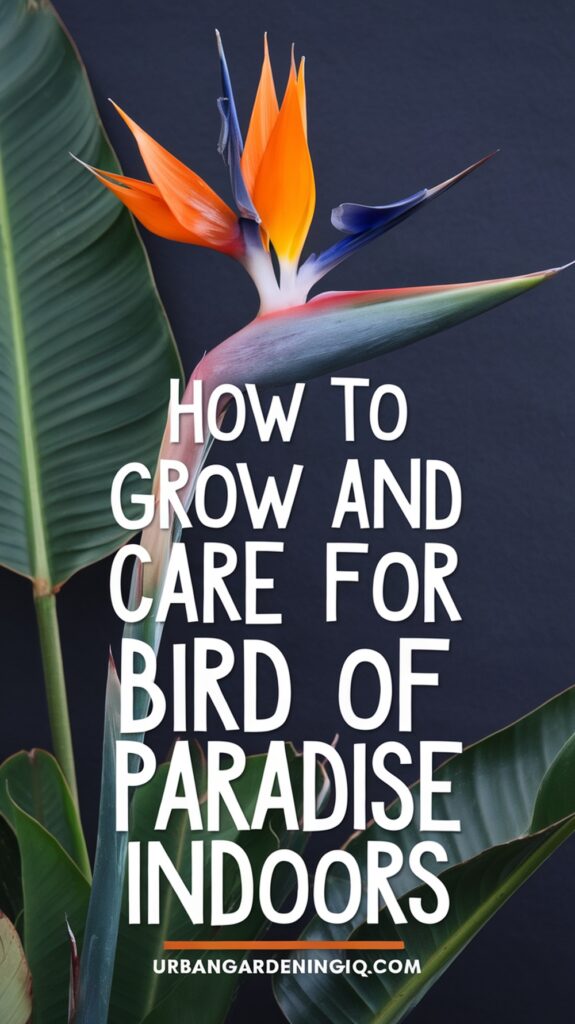
Adding a Bird of Paradise to your home does more than just add greenery. It creates an indoor jungle look. This plant stands out as a statement piece, making any room more interesting. Its lush leaves and occasional blooms make it a highlight in any tropical plant collection.
For a jungle feel, pair it with plants like pothos or bold ferns. Choose a stylish pot, like sleek ceramic or natural terracotta. Place it where light is plentiful, like a sunny corner or entryway. This makes your bird of paradise display eye-catching and fits any decor.
Even if you’re new to plants, growing a Bird of Paradise is rewarding. It grows slowly but steadily, becoming a beautiful piece of art. With the right care, it proves that tropical beauty can thrive indoors, with patience and the right conditions.

